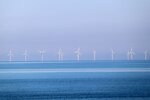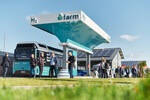12/10/2008
USA - Wind energy feasible for livestock producers
A recent study, partially funded by a Colorado Department of Agriculture Value-Added Development grant and Colorado Livestock Association, found that wind turbines can pay for themselves in as little as nine years, or as much as 30 years, depending on site-specific circumstances and financing.
“This study looked at the economic feasibility of utilizing wind power at livestock operations located in Elbert, Morgan and Yuma counties,” said CDA’s Markets Division Director, Tom Lipetzky. “It shows that wind-generated electricity can be cost-effectively produced at livestock operations in Colorado under the right conditions and that is a positive step toward Colorado’s renewable energy future.”
A grant from CDA’s Advancing Colorado’s Renewable Energy (ACRE) program helped fund the study. ACRE promotes agricultural energy related projects. For more information on this program, click here.
According to the study, the keys to installing an economically viable wind turbine include:
- Having at least Class II average wind speed (13.2 to 15 mph).
- Using most of the wind-generated electricity internally (i.e., on the customer side of the meter).
- Matching turbine output to electricity usage (i.e., minimizing excess electricity sold to the power grid).
- Negotiating a favorable electricity buy-back arrangement with the local cooperative electric association.
The study, conducted by Brink, Inc., a Lafayette-based environmental consulting company, estimated the cost and electricity output of eight wind turbines, ranging in size from a small 1.9-kilowatt residential unit to a commercial-scale, 1.6-megawatt turbine. Wind turbine costs and estimated outputs were compared with each livestock operation's wind speed, electricity usage and costs to determine the value of wind-generated electricity and turbine pay-back times.
"This research confirmed that we have a valuable wind resource in this area of the state, and that it can be harvested cost-effectively," said Kenny Rogers, owner of Wagon Wheel Ranch, a farming and registered Angus cattle operation in Yuma County, and one of the study participants. "We're now in the process of collecting a year's worth of wind speed and direction data to determine our site-specific wind potential."
The August 2008 study report, titled, "Wind Feasibility Report for Colorado Livestock Operations," also found that:
- In most cases, the turbine output that most closely matches a facility’s usage will be the most cost-effective unit for that operation.
- The more electricity an operation uses, the more likely wind-generated electricity will be economically feasible, if the site has an adequate wind resource.
- Besides electricity, wind turbines also produce Renewable Energy Credits (RECs), which can be sold to companies and individuals interested in purchasing carbon offsets. Renewable Energy Credit producers should shop around to get the best price for their RECs.
- Grants, low-interest loans and tax credits are available and can be used to reduce the installed turbine cost and corresponding payback time frame.
The study cautions that anyone considering a wind turbine should first determine their site-specific wind characteristics by measuring it for one year, since average wind speed can vary significantly even within a short distance. This involves installing wind-speed and direction-monitoring equipment on a tower or antenna.
"Potential customer-generators should also talk to their local cooperative electric association about the price that the utility would pay for excess electricity delivered to the power grid," said Phil Brink of Brink, Inc. "If a customer-generator is producing more electricity than he uses, it is usually delivered to the power grid. The greater the excess electricity delivered to the grid, the more important the utility's excess electricity buy-back becomes in determining a wind turbine's return on investment."
For more information, please contact Trevor Sievert at ts@windfair.net
“This study looked at the economic feasibility of utilizing wind power at livestock operations located in Elbert, Morgan and Yuma counties,” said CDA’s Markets Division Director, Tom Lipetzky. “It shows that wind-generated electricity can be cost-effectively produced at livestock operations in Colorado under the right conditions and that is a positive step toward Colorado’s renewable energy future.”
A grant from CDA’s Advancing Colorado’s Renewable Energy (ACRE) program helped fund the study. ACRE promotes agricultural energy related projects. For more information on this program, click here.
According to the study, the keys to installing an economically viable wind turbine include:
- Having at least Class II average wind speed (13.2 to 15 mph).
- Using most of the wind-generated electricity internally (i.e., on the customer side of the meter).
- Matching turbine output to electricity usage (i.e., minimizing excess electricity sold to the power grid).
- Negotiating a favorable electricity buy-back arrangement with the local cooperative electric association.
The study, conducted by Brink, Inc., a Lafayette-based environmental consulting company, estimated the cost and electricity output of eight wind turbines, ranging in size from a small 1.9-kilowatt residential unit to a commercial-scale, 1.6-megawatt turbine. Wind turbine costs and estimated outputs were compared with each livestock operation's wind speed, electricity usage and costs to determine the value of wind-generated electricity and turbine pay-back times.
"This research confirmed that we have a valuable wind resource in this area of the state, and that it can be harvested cost-effectively," said Kenny Rogers, owner of Wagon Wheel Ranch, a farming and registered Angus cattle operation in Yuma County, and one of the study participants. "We're now in the process of collecting a year's worth of wind speed and direction data to determine our site-specific wind potential."
The August 2008 study report, titled, "Wind Feasibility Report for Colorado Livestock Operations," also found that:
- In most cases, the turbine output that most closely matches a facility’s usage will be the most cost-effective unit for that operation.
- The more electricity an operation uses, the more likely wind-generated electricity will be economically feasible, if the site has an adequate wind resource.
- Besides electricity, wind turbines also produce Renewable Energy Credits (RECs), which can be sold to companies and individuals interested in purchasing carbon offsets. Renewable Energy Credit producers should shop around to get the best price for their RECs.
- Grants, low-interest loans and tax credits are available and can be used to reduce the installed turbine cost and corresponding payback time frame.
The study cautions that anyone considering a wind turbine should first determine their site-specific wind characteristics by measuring it for one year, since average wind speed can vary significantly even within a short distance. This involves installing wind-speed and direction-monitoring equipment on a tower or antenna.
"Potential customer-generators should also talk to their local cooperative electric association about the price that the utility would pay for excess electricity delivered to the power grid," said Phil Brink of Brink, Inc. "If a customer-generator is producing more electricity than he uses, it is usually delivered to the power grid. The greater the excess electricity delivered to the grid, the more important the utility's excess electricity buy-back becomes in determining a wind turbine's return on investment."
For more information, please contact Trevor Sievert at ts@windfair.net
- Source:
- Online editorial www.windfair.net
- Author:
- Edited by Trevor Sievert, Online Editorial Journalist
- Email:
- ts@windfair.net
- Link:
- www.windfair.net/...
- Keywords:
- wind energy, renewable energy, wind turbine, wind power, wind farm, rotorblade, onshore, offshore


























